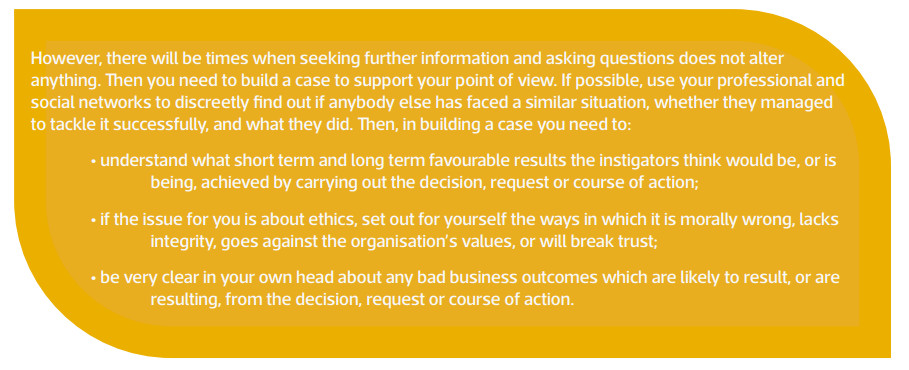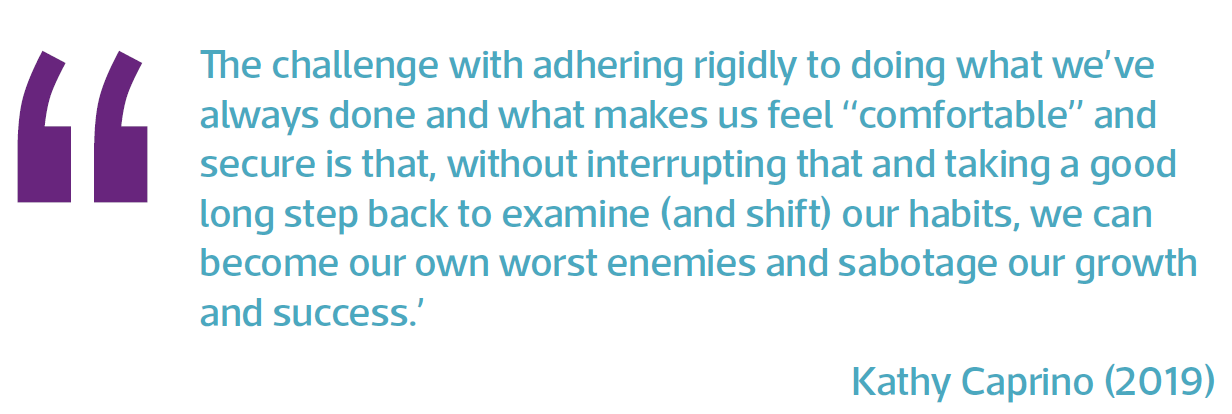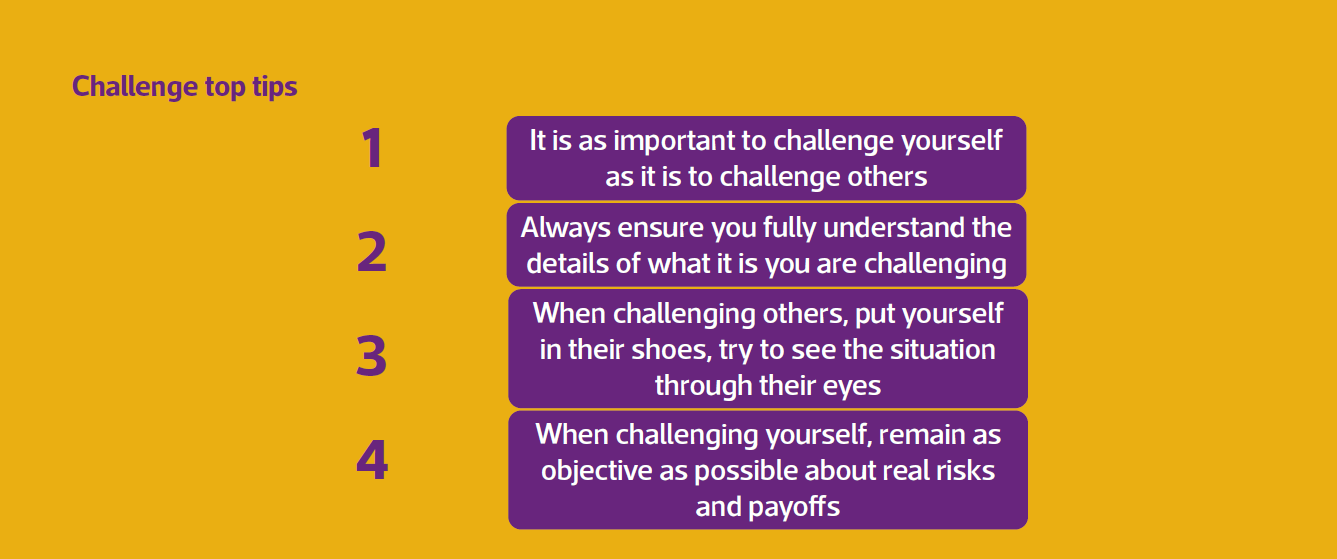A manager is a realist; they are managing and maintaining performance. A leader is a visionary who will challenge [the] status quo and innovate. Managers excel in the now of process planning and execution, while leaders focus on impact, motivation and the future. The transition happens within a mindset shift. Leaders ask their teams “why” instead of “how.”
Leanne Wong (2017)
Presenting a Case
It is essential that you have understood the matter that you feel ought to be challenged. Gather as much information about it as possible. Ask questions of the relevant manager(s) or colleague(s). Sometimes you might feel you are asking silly questions, that everybody understands something that you must have missed, in order to have taken such a decision. Be assured that this is rarely the case. A decision, request or behaviour may have been made or enacted without a full realisation of the consequences. On many occasions, the asking of questions will be all that’s needed for realisation to dawn, and the decision, request or course of action changed.
Sometimes, particularly in the case of unethical behaviour, the realisation does in fact already exist, and the slight ‘challenge’ of your questions can lead to second thoughts.

Empathy
Remain calm, use open body language and maintain relaxed eye contact. Adapt your use of language to theirs as much as you can without coming across as inauthentic. Don’t use specialist words they may not be familiar with, for example.
First, if the situation allows, build or re-establish rapport. Establish that you and the person that you are challenging have the same overall goals – the success of the organisation, or department, for example, in whatever way that is interpreted (such as increased sales in the long term, a greater share of the market or increased consumer satisfaction).
If you can do it subtly, ‘mirror’ the other person’s body language. This creates feelings of empathy. Ask lots of questions, if you haven’t already, to find out exactly why the person(s) whose decision/request/course of action you are challenging is supporting it; listen carefully, and be seen to be listening carefully (McCann, 2016). You may find that the person’s emotions and feelings (which are underpinned by their needs and drives) play as big, if not a bigger part, as rational logic. In this case, being logical in your arguments will not be enough to persuade them (Goleman, 2000).
For example, if the person thinks this course of action will make their own job more secure, talk about how this can have precisely the opposite effect. If they are ambitious, how might this affect their future career? If they need to be seen as clever, cunning or one step ahead, how might this backfire? If they want to be popular and think this is the way, talk about how this could have exactly the reverse effect (Fisher & Ury, 2012).
When you have been through all these stages, set out the agreement you want and what action is needed next. This might sometimes simply be non-action, but this also needs to be stated.
Comfort Zones and Challenging Yourself
might want to settle for ‘a quiet life’ and avoid such confrontations. We might decide, particularly when the
challenge is about ethics, that it may harm our career. The latter is unlikely if you follow the steps set out in
the previous section, however, in either case, not to take action can result in a loss of your integrity. This will
be particularly harmful to the relationship and trust between you and your team. It might also be harmful
to your own belief in yourself, and your self-confidence. So it is just as important to challenge yourself,
in the face of fear (or procrastination) - not just to confront others, or to have the courage to always do the right
thing yourself - but to fulfil your own potential.
This does not simply refer to applying for better paid and more responsible jobs, it is also relevant to
exploring the full range of what is possible within your current role. Have you got set in your ways? Are
you doing things because this is always the way you’ve done them? Are you prepared to be open to
changing your mind about something? Have you formed previous opinions on emotional rather than
rational grounds? Challenging yourself is intrinsic to change, growth and even survival. Trying to push
your own boundaries on a regular basis opens up your horizons. It is by thinking about this that you will
gain confidence that what you’re doing is right.
As suggested by Mahoney (1998), this does not mean that you must constantly take risks, but do be
realistic about those risks. What do you risk losing, and what might counteract that anyway? Keep in mind
what you or your team have to gain. What additional ‘safety measures’ can you put in place (e.g. further
training or the support of a mentor or coach). If you cannot think of ways in which you could be challenging
yourself, ask a trusted colleague or your own manager, or even a good friend. (And be prepared to be
surprised – they’re not called ‘blind spots’ for nothing!)


References
Caprino, K. (2019). How Stepping Away From Work And Leaving Your Comfort Zone Boosts Your Success. Forbes [online].
Available from: https://www.forbes.com/sites/kathycaprino/2019/08/27/how-stepping-away-from-work-and-leaving-your-comfort-zone-boosts-your-success/ [Accessed 9 Aug 2022]
Fisher, R. & Ury, W. (2012) Getting to Yes: Negotiating An Agreement Without Giving In. Reading, Berks: Random House Business.
Goleman, D. (2000) Working with Emotional Intelligence. 1st ed. London: Bloomsbury.
Mahoney, J. (1998) Cultivating Moral Courage in Business. Business Ethics: A European Review. 7 (4), pp. 187-192.
Available from: https://doi.org/10.1111/1467-8608.00106 [Accessed 9 Aug 2022]
McCann, D. (2016) How to Influence Others at Work. 2nd ed. Oxon: Routledge.
Wong, L. (2017). What Makes A Good Leader? Key Differences Between Management And Leadership. Forbes [online].
Available from: https://www.forbes.com/sites/forbescoachescouncil/2017/11/20/what-makes-a-good-leader-key-differences-between-management-and-leadership/ [Accessed 9 Aug 2022]
How do you challenge others? Test yourself with our Scorecard.
If you’re a member, you can test yourself on Challenging and see if you meet the standard.
Spotlights
Further Resources
From the Blog








